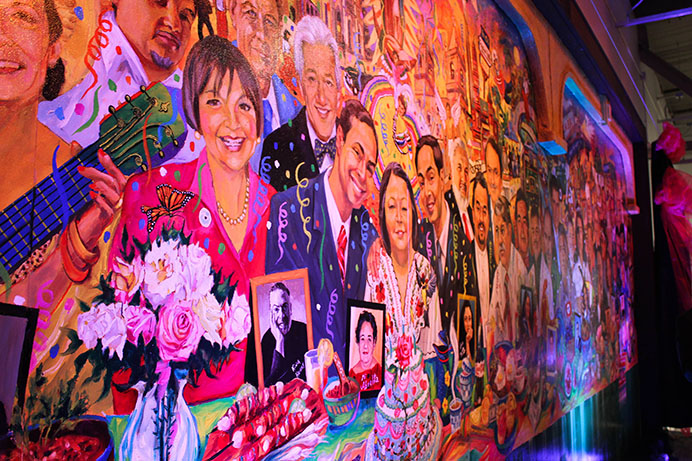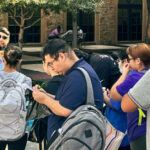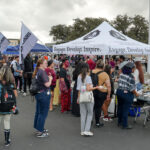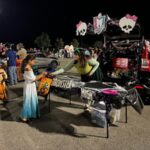
By Nicole West
Silver balloons fell from the ceiling Friday night at the university’s new downtown education and cultural arts center bearing the center’s new name: Casa Rosa.
As the balloons were released they fell onto the shoulders of some of San Antonio’s most prominent politicians and educators in the city who had gathered for not just one party, but two…or, three. It’s San Antonio, afterall.
The celebration, held in the former downtown Museo Alameda, paired a mother’s day celebration to honor Rosie Castro, mother of San Antonio’s Mayor Julian Castro, with the unveiling of the campus’ new downtown cultural arts center’s name and vision.
The evening’s celebration brought together Latino politicians with university presidents, community leaders and other local dignitaries on the eve of San Antonio general elections in which Castro would easily win a third term as mayor.
Henry Cisneros, former mayor of San Antonio and United States Secretary of Housing and Urban Development under the Clinton administration, served as master of ceremonies. U.S. Congressman Joaquin Castro and Mayor Julian Castro with his wife and daughter, were among prominent guests to honor their mother’s long history of local civic activism.
Other guests included the Cortez family, owners of three restaurants in historic Market Square, local artists, city employees, university faculty and Ricardo Romo, president of the University of Texas at San Antonio.
The city’s two public university presidents stood hand-in-hand at one point to celebrate their accomplishments in higher education and the university’s expansion to the city’s downtown core and Zona Cultural.
Communications Specialist Jillian Reddish estimated about 500 people attended the event.
A fresh start
Can a failed museum have a new beginning?
On stage, there was no talk of the former Museo Alamada or the building’s closure following financial struggles during its nearly five years of operation. Speeches focused on family, community, education, and on the future.
The former Museo Alameda, the first formal Smithsonian Institution affiliation under the Affiliates program in the nation, closed in September 2012 following financial struggles.
The museum was $1.5 million in debt and received a $450,000 bailout from the city that year, as it struggled to stay open but never drew the crowds to keep it afloat. The university, wishing to begin an arts and education center downtown, acquired the former Latino museum building in 2012 when the facility closed. In a collaborative agreement, the city is contributing $450,000 in funding for the next three years.
No formal announcements were made Friday about the center’s programming, but task forces at the university and city have been meeting in advance of the center’s expected fall opening.
A vision statement, recorded as an audio track, played as part of the center’s unveiling: “We’ll start with showcasing San Antonio’s artists; it’s poets, its writers, and its historians. As the weeks and months go by, we’ll add important exhibits, relevant documentaries, books, artifacts, a library, architectural models and yes- the stories of the places that were saved from demolition and destruction, the courageous women and men who saved them, and sowed the seeds to this magical place we call “Nuestro San Antonio.'”
The city’s department for culture & creative development is in the final stages of hiring a cultural program manager for Casa Rosa. A city job posting was announced and posted earlier this spring. The hire is expected to formulate and advance a mission, vision and program for the gallery spaces, according to the public job posting.
Sociology professor Rosario Torres, who spearheaded the university’s task force, declined to comment on how the university and city are working together. However, a detailed job description suggests close collaboration.
The partnership “provides an opportunity to unite the various programs, activities and facilities, within the zona cultural, with Texas A&M’s strength in applied arts and sciences and interdisciplinary studies, with a program focus on urban planning, historic preservation, architecture, adaptive reuse and historic revitalization,” reads the job posting.
Collaborative energy, effort

Accompanied by toasts and laughter, Ferrier and Texas A&M System Chancellor John Sharp — or “Juan Filoso” as Ferrier called him — unveiled the name of the former Museo Alameda.
Sharp said they wanted the name to reflect warmth of a home and promise of a new future.
Some guests thought the center was directly named after San Antonio activist Rosie Castro. But Reddish described the name similarity as a “happy coincidence” and confirmed there was no direct connection.
The name Casa Rosa is more related to the hot pink building, and the rose at the center of the new logo is a symbolism and importance of the yellow rose as a state symbol, Reddish said.
The new branding aligns the center’s vision and programming with its location at the heart of Zona Cultural, according to a university press release.
Zona Cultural, or cultural zone, is the downtown area encompassing historic Market Square, Casa de Mexico, the Alameda Theater and the Henry Ford Academy: Alameda School of Art + Design, a magnet high school.
Unveiling of a mural
Toward the end of the evening, guests applauded as the curtains were drawn back by Jorge Cortez and Mi Tierra employees unveiling a 33 foot mural depicting Rosie and her twin sons, Ferrier and other local and regional dignitaries.
The mural was commissioned from San Antonio artist Armando Sanchez and will reside at Pico de Gallo, a restaurant located at San Antonio’s historic Market Square.
“We were approached by Jorge Cortez who is developing Zona Cultural, about the unveiling of the mural and we realized it will be great fit,” Reddish said. “We were very happy that they were willing to share the event with us.”
Chicano poet Nephtalí De Leon closed the event by reading his poem dedicated to Rosie, “Día de las Madres at the Market Square,” in front of the symbolic mural. The bilingual poem expressed all the reasons for the evening’s celebration, including Mother’s Day, the museo’s renewal, generations of work and sacrifice, and the city’s history and vibrant culture.
It reads in part:
It was the unveiling of a mural
the mother of the mayor was there
and her honorable sons, one a mayor,
the other a legislator in state, and the former
mayor introduced them — all Indian faced
indios and indias in tennis shoes made it big
they were the leaders of our state
known to so many far and wide…
As the evening came to a close, silver balloons bounced lightly across the floor and guests offered their final applaud. Some joined each other on the stage to have their photographs taken in front of the mural.






